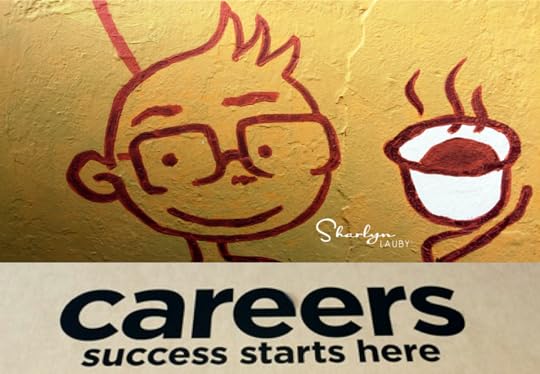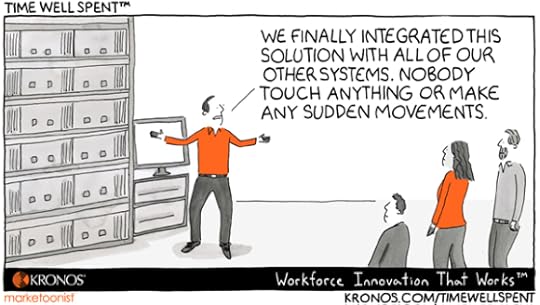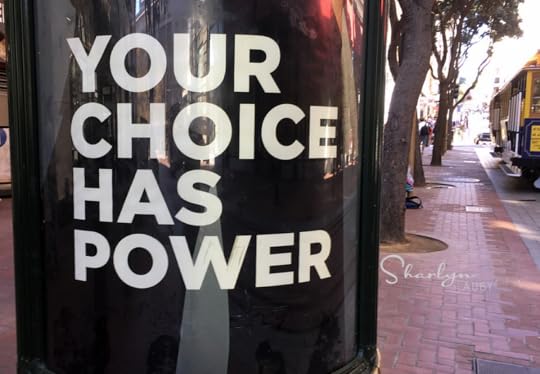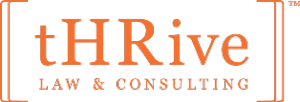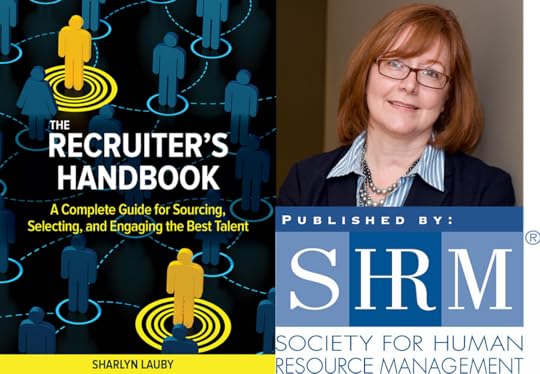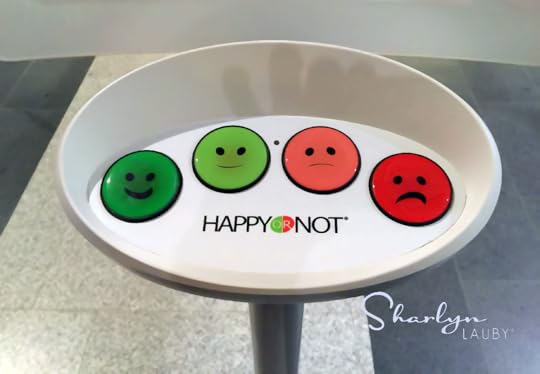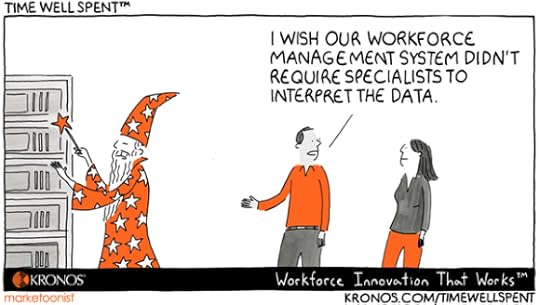Sharlyn J. Lauby's Blog, page 119
April 22, 2018
What Do Job Seekers Want from Recruiters [Survey]
A few weeks ago, I published an article about the things that recruiters want from job seekers. I received a comment saying that it would be interesting to look at the flip side:
What do job seekers want from recruiters?
I agree it would be very interesting to find out so, I’m giving you an opportunity to weigh-in and share your thoughts. I’ve created a survey that asks one question of job seekers: Besides “getting the job”, what do you expect from the recruiter and hiring manager during the hiring process? It’s an open-ended question so, just follow the link below and you’ll have the opportunity to fill in your answer. And you can make it as brief or as long as you wish.
The survey is also anonymous. So, don’t worry that I’m going to publish your name somewhere. The goal is to pass along some good information to human resources and talent acquisition professionals.
I’m going to leave the survey open for a couple of weeks, so if you can’t answer it right now, I hope you’ll come back when you have a moment and respond. It really shouldn’t take you more than 3 – 5 minutes to complete. And if you have friends who are job seekers and have an opinion on this subject, share it with them too. The more responses, the better the information I can pass along to recruiters.
Thanks so much (in advance) for taking the time to comment. I’m looking forward to seeing your responses!
The post What Do Job Seekers Want from Recruiters [Survey] appeared first on hr bartender.






April 20, 2018
Employees Should Test Limits – Friday Distraction
Remember the old MC Hammer song, “U Can’t Touch This”? I realize I might be dating myself since some of you might know him better as the spokesperson for 3M Brand Command Strips. The reason I’m thinking about MC Hammer these days is because Mr. Bartender and I are in the process of moving. And the realtor helping us sell our home keeps coming in, rearranging our house, and telling us “don’t move this!” ha.ha.
I know our realtor is only doing her job. And we all want the same things. But it’s still frustrating. Today’s Time Well Spent cartoon from our friends at Kronos reminded me of those times when the same thing happens in a work context. The company builds a perfect process knowing its limits or gets a system organized, then makes the declaration, “Don’t touch it!” It seems counterintuitive.
It makes no sense to create a process that people can’t use. That’s the equivalent of creating a process for one employee. I’ve never understood creating company policies for the exceptions. Manage the exceptions and create policies that benefit everyone.
The real value of a process or system is in the way that it’s used. I believe organizations should create processes or systems to make employees lives easier (not more cumbersome). Now, easier doesn’t always mean fewer steps. It’s possible that the value of a process comes in extra steps but less repetition. Or more steps and less complaints.
Using a system or process can help keep it current.The more individuals use a process, the easier it can be to identify bottlenecks or breakdowns in the process. If employees don’t use a process for weeks or months and then have to use it, they may or may not immediately see the challenges.
Technology can make processes more user-friendly. If one of the reasons that the company is reluctant to let employees test the limits of their systems is because the systems are manual, consider adding technology. This can allow employees to feel comfortable working within systems knowing that they’re not going to mess it up.
Organizational systems and processes should be regularly monitored to make sure they are 1) doing what they’re supposed to and 2) remain current with the times. When processes need updating, managers can get employees involved. Employees can buy-into the system that they’re going to use daily. It’s a win for everyone.
The post Employees Should Test Limits – Friday Distraction appeared first on hr bartender.






April 19, 2018
Job Seekers – – Keep Your Contact Info Current and Answer Your Phone
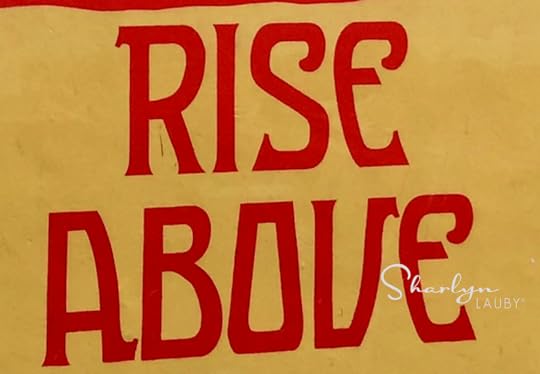
I recently wrote a post about what recruiters would like job seekers to do when they apply for a position. The list includes submitting a cover letter, researching the company, and coming to interviews prepared. But applying for a job is only one way of getting a new position. Another way is when a recruiter seeks you out.
I’ve gotten more than one job in my lifetime by a recruiter contacting me first. Here’s the thing though…if you want a recruiter to contact you, they have to be able to find you.
During last year’s Recruiting Trends & Talent Tech Conference, I listened to several recruiters vent their frustrations about candidates that don’t keep their contact info current. You know, old phone number and emails. Abandoned social media accounts.
The reason I bring this up is because it takes relatively little time to keep the contact info on your social media accounts current. (FYI – I wrote a post on the Unum WorkWell blog recently about personal social media audits.) Even if you’re not looking for a job right now, you never know when the job of your dreams might be presented. If that’s the case, I’d like to think you want that opportunity to find you.
The second thing that recruiters were frustrated about was candidate responses. More specifically, a lack of responses. We’ve talked several times here on HR Bartender about how to follow-up after an interview, etc. After listening to the conversations recently, I get the impression that might be the exception and not the rule. Let me toss out my two-cents for consideration. If a recruiter contacts you, it makes sense to answer them. Even if you’re not interested. Let them know, “I’ve got a great job. Very happy here. Thanks for thinking of me.”
I will add, if a recruiter is doing a generic blast of open positions (sometimes known as “spray and pray”) then you don’t have to answer them. But if they specifically contact you, take a moment to respond.
When the job market has more demand than supply, it would be logical to expect more recruiters to start actively sourcing candidates. That means, people should expect unsolicited calls and emails to see if they’re interested in an opening. Answering a recruiter doesn’t mean you have to apply for the job, go on an interview, or feel guilty.
It could be the start of building a positive working relationship with someone that can help you with your future career goals. So take a moment to update your contact info and remember the old quote, “Eighty percent of success is just showing up.” Or in this case, just answering the phone.
Image captured by Sharlyn Lauby while exploring the Wynwood Walls in Miami, FL
The post Job Seekers – – Keep Your Contact Info Current and Answer Your Phone appeared first on hr bartender.






April 17, 2018
Everything #HR Needs to Know About Machine Learning
Have you seen the GE commercial about “Molly, the Kid Who Never Stops Inventing”? Every time I see it, I’m reminded about how robots are becoming a greater part of our workplace. And that’s not a bad thing, but it does mean that we need to get more comfortable with today’s technology concepts.
That’s why I’m very excited to share today’s interview with you. A few weeks ago, I wrote about Kronos’ new next generation workforce management solution called Workforce Dimensions. Dr. Thomas Walsh is the director of data science at Kronos, where he leads the application of cutting edge machine learning (ML) and artificial intelligence (AI) techniques to workforce data. His work includes designing AI solutions around compliance and business forecasting for Workforce Dimensions.
Walsh received his PhD in computer science from Rutgers University and has held research positions in both academia and industry. His work has covered diverse fields from robotics to educational modeling, and now workforce management. He is the author of over 30 peer-reviewed publications in the fields of ML and AI. And he very graciously agreed to share a little of his expertise with us about machine learning.
Dr. Walsh, can you briefly describe machine learning and how it differs from artificial intelligence?
[Walsh] Machine learning (ML) and artificial intelligence (AI) can be tough fields to pin down.
Artificial intelligencerefers to a collection of subfields thatsolve complex problems associated with human intelligence and/or interacting with the world. These subfields include computer vision, natural language processing, robotics, and machine learning.
Machine learninggenerally covers methods that build models of complex data.
There are many types of ML approaches, and it is important to choose the right type of solution for the specific business problem at hand. For instance, in the workforce management space, Kronos uses unsupervised ML algorithms that uncover patterns in data to find potential compliance violations. But in the Workforce Dimensions product, Kronos uses a different type of ML, supervised ML regression, for business volume forecasting.
Each of these types of ML has its own idiosyncrasies, but the one thing they all have in common is that they are driven by the data they are given. In the same way a new recruit might need time on the job to learn all the idiosyncrasies of your office, ML algorithms tend to work better as they receive more data.
Why should human resources professionals pay attention to machine learning?
 [Walsh] In the last decade, HR professionals have seen the amount of data they oversee proliferate. Data elements around skills, staffing, performance, payroll and many other areas have grown both in complexity and size. With all of this data it is getting harder and harder to simply view your data in a spreadsheet and quickly find the problems, let alone the solutions.
[Walsh] In the last decade, HR professionals have seen the amount of data they oversee proliferate. Data elements around skills, staffing, performance, payroll and many other areas have grown both in complexity and size. With all of this data it is getting harder and harder to simply view your data in a spreadsheet and quickly find the problems, let alone the solutions.
Machine learning holds the promise to unlock the hidden value in all this data that can no longer simply be perused by hand. For instance, machine learning can uncover patterns, such as those that might indicate compliance risk, and surface outliers that otherwise might have flown under the radar.
Similarly, the patterns detected by machine learning can uncover the root causes of key outcomes like turnover or daily business volume and even predict how these key performance indicators (KPIs) will trend in the future. All of these are use cases that HR professional have confronted for decades, but the growth of Big Data means machine learning tools are now capable and even needed to confront these familiar problems.
We keep hearing stories about how robots are going to replace humans. Can you give readers an example of how can machine learning can actually help people do their jobs?
[Walsh] No one is suggesting you turn your HR functions over to a robot, but there are plenty of areas where machine learning can help make manual tasks more efficient and provide insight that a human staring at rows and rows of data might have missed.
A great HR example is around compliance auditing. While many compliance regulations are enforced by rules in human capital management (HCM) and workforce management systems, more subtle violations are often lost in a haystack of Big Data.
For instance, small changes to an employee’s timecard might result in reduced overtime or meal break violations. Such changes may be nuanced, affecting only a few minutes at a time, and unfortunately there are hundreds of thousands or even millions of small edits in most organizations, most of which are not violations. Investigating them all by hand is not practical, but machine learning algorithms can uncover needles in this haystack and determine locations, departments, or employees that show abnormal patterns indicative of compliance violations. Not only does this make the auditor’s job easier, but it helps individual employees by ensuring fairness in time, attendance, and pay policies as well.
For organizations that are thinking about bringing machine learning into their workplace, what are 1-2 things they need to consider?
[Walsh] Machine learning is not one single algorithm or even one particular class of algorithms. Instead, there are many kinds of ML techniques, including:
Unsupervised learning to uncover patterns
Supervised approaches to predict outcomes for new data points
Other variants like reinforcement learning
Ensuring success with these technologies starts by building the right business process around their use. Specifically, before bringing in any ML solution, you need to clearly define the business problem you are trying to solve and the metrics for measuring success.
Defining the business problem, such as ‘find potential compliance violations’ or ‘predict future business volume’ is the key to finding the right variant of ML to deploy. For instance, if you need to predict business volume in the future based on previous trends, you have a classical supervised ML regression problem. While data scientists and other experts can help you wade through the jargon of ML terminology, they won’t find the right solution unless you state the business problem concretely and set down clear success criteria.
Are there any potential downsides that organizations should discuss before bringing machine learning into the workplace?
[Walsh] For many workers and managers, the terms ‘artificial intelligence’ and ‘machine learning’ can evoke mixed feelings. While there is certainly promise that routine tasks could be automated by AI and ML, there can also be confusion about what a new system using these technologies will actually do.
A recent study from the Workforce Institute found that employees were excited to embrace the benefits of AIbut a lack of communication from employers about its impact left them feeling apprehensive. For many of these employees, it seems that clear communication from employers about what they expect an ML system to do and why it is necessary can go a long way to allaying these concerns. As with the introduction of new technology, communication and training make the process much smoother.
How do you see machine learning evolving over the next 3-5 years?
[Walsh] The rising use of ML is part of a growing trend towards allowing data to drive previously hard-wired processes. As an example, consider the problem of forecasting business volumes.
Decades ago, a person might stare at a spreadsheet and try to determine how many transactions a business would do a week from now. Later, static formulas were derived that made this process more automatic. Data from previous weeks and years were fed to a hand-crafted computer program and it predicted the number of transactions. But now a machine learning system like the one used in Workforce Dimensions can make forecasting even more data driven and reliable.
The ML system does not just feed data to a formula, but instead constructs the formula itself based on historical data, determining the factors and trends that are most predictive of your business.
The future for ML in the HR space is full of use cases that are ready to make this next leap in data driven innovation. While there will always be a human in the loop for these systems, over the next 3-5 years more and more areas of HR and workforce management will start to harness the power of their data to undergo similar transformations.
A HUGE thanks to Dr. Walsh for sharing his expertise with us. As you can see, we’ve only just scratched the surface in this conversation about the capabilities of machine learning.
As HR pros, we play a key role in designing work, which means we need to have an understanding of these technologies, so we can design work that’s meaningful for employees and valuable for the business.
Image captured by Sharlyn Lauby after speaking at the Flora Icelandic HR Management Conference in Reykjavik, Iceland
The post Everything #HR Needs to Know About Machine Learning appeared first on hr bartender.






April 15, 2018
What Is the Appropriate Discipline for Disrespectful Behavior – Ask #HR Bartender
We’ve talked before about employee suspensions: how to handle themand what happens during a suspension. But today’s reader note goes into an area that we haven’t spent much time talking about – progressive discipline.
I received a suspension for ripping company policy papers in half in front of my supervisor.
A couple of days ago, I received a written warning for wearing my uniform home. During the conversation, I asked my supervisor for a copy of the company policy on uniforms. He didn’t give it to me, but instead read me the policy. Later, he gave me a copy of the policy, but since he had already read the policy to me…I didn’t need it anymore so tore it up.
My supervisor got severely agitated because I tore the policy in half in front of him. My next shift, I got called into his office and was a 1-day suspension due to “disrespectful behavior”. Do I have an argument here?
Of course, we don’t have the supervisor’s side of the story, and I’m sure the company has their perspective. So even though we might not be able to address some specifics, I think this scenario raises some great questions about codes of conduct and progressive discipline.
To help us understand this matter, I asked our friend Kate Bischoff to share her knowledge. Kate is an employment attorney and HR consultant at tHRive Law & Consulting LLC. She’s shared her experience with us before – one of my favorite articles is this one about “HR Failed to Investigate an Incident”.
I know you realize this, but please remember that Kate’s comments should not be construed as legal advice or pertaining to any specific factual situations. If you have specific detailed questions, they should be addressed directly with your friendly neighborhood labor attorney.
Kate, thanks for helping us with this reader note. Because all employees come from different backgrounds, and have different experiences, etc., is it true to say that most organizations have some sort of code of conduct? You know, a set of rules that we all need to abide by? And if so, what types of behaviors are usually included in a code of conduct?
 [Bischoff] YES! Employers need a code of conduct. It doesn’t even need to be called a code of conduct. That said, employers need to set expectations by outlining their standards of respect, attendance, and dress code as well as prohibitions against harassment and discrimination. Some employers may have additional policies or language for their industry or business.
[Bischoff] YES! Employers need a code of conduct. It doesn’t even need to be called a code of conduct. That said, employers need to set expectations by outlining their standards of respect, attendance, and dress code as well as prohibitions against harassment and discrimination. Some employers may have additional policies or language for their industry or business.
Also, do not have a list of all the things employees could do to get in trouble. Employees are a creative lot. They will find umpteen ways to get in trouble. Instead, employers should include language like “We expect employees use good judgment in all situations.” While this is a wholehearted steal from Nordstrom’s, it is not wrong. If an employer says that it expects good judgment and an employee does something stupid, you should discipline even though the stupid wasn’t in your handbook. A policy prohibiting stupid isn’t a prerequisite to discipline.
In this case, we don’t know what the company’s policies and procedures are…but let’s say that the company has a uniform policy and the employee was in violation of the policy. Does a violation of the policy warrant a written warning?
[Bischoff] Here’s the lawyerly answer – it depends. Absent a collective bargaining agreement with a union, employers have discretion to determine what discipline to give to an employee for any infraction. That said, employers should operate with a sense of fairness. Here are questions the employer should be able to answer when determining the appropriate discipline.
Has a written warning been issued for a uniform violation before?
Would a written warning get the employee to comply in the future?
Would a written warning set the right tone in line with the company’s culture?
There are many different levels of discipline. Even in nonunion workplaces, employees expect that employers will use progressive discipline, discipline that starts mild and ends severe – verbal warning, written warning, (maybe) suspension, and finally, termination. Depending on the misconduct, employers can then escalate to the appropriate level when the misconduct is repeated. However, the more severe the infraction, the more severe the discipline. If an employee is tardy three times, a verbal warning may be appropriate. If an employee steals a company car, the employee should be fired.
Employers have the discretion to select whatever discipline they deem fitting. When determining the right level of discipline, employers should consider other discipline given to the employee, what has been done in the past, and what level would stop the misconduct going forward.
Employers: “A policy prohibiting stupid isn’t a prerequisite to discipline.” - @k8bischHRlaw #HRClick To Tweet
Sometimes employees don’t make the same mistakes twice. They do make a lot of mistakes though. If an employee is constantly violating company policy, but not doing the same infraction, is it okay to start progressive discipline?
[Bischoff] Yes. Let’s say Jeremy showed up to work a half hour late. He gets a verbal warning. He doesn’t show up in his uniform on a different day. If Jeremy hadn’t already received a verbal warning, Jeremy would have received another verbal.
Some employers would run two series of discipline – one for the tardy another for the uniform – so Jeremy would have two verbal warnings. Other employers would have only one track, meaning Jeremy would have a written warning for the uniform because he had already received a verbal warning. Again, the discretion is with the employer. Provided the employer handles these matters consistently, there isn’t a problem.
Let’s talk about the paper ripping incident. I can see both sides here. On one hand, the employee ripped up a company document. On the other, the employee was venting, which we all do sometimes. I don’t know that we can say who’s right but what are the pros/cons of disciplining the employee for this?
[Bischoff] I totally get the need to vent. However, venting by ripping up a policy I’d just violated in front of my supervisor sounds awfully sassy to me. Sassy to some can be insubordination to others. While we don’t know all the facts here, the employer was within its rights to discipline, including suspending the employee. The pros of suspending would be stopping the behavior because the gravity of the discipline is pretty substantial.
The big con here could be how other employees would view the discipline. Even though we try to discipline confidentially, other employees learn about discipline quickly especially if an employee is suspended and not there. Whether we want them to or not, employees take sides. If they viewed the suspension as unfair or retaliatory, then it will affect morale and overall productivity. If they saw the ripping up and it was sassy, the suspension might actually improve morale.
Final question, and this is for the organizations out there reading this scenario. If a company is faced with a situation like this and wondering the best way to proceed, what should they do?
[Bischoff] Employers should first try to ascertain what happened, which includes speaking with the employee and the manager. Then, review the employee’s history to determine if there has been other discipline, review any relevant policies or other similar discipline that has similar circumstances, and finally talk with the supervisor about the appropriate level of discipline.
Lastly, have a candid conversation with the employee about the situation. While disciplining is really important to the overall health of an organization, making sure the employee understands what is happening and whyis equally important.
A HUGE thanks to Kate for helping us with this. If you want to read more of Kate’s insights, be sure to check out her blog. It’s a must read.
There are a lot of moving parts to progressive discipline. The key is to be consistent. And Kate didn’t mention it, but I will, if you’re an HR pro and need someone to listen and bounce some thoughts around with, don’t hesitate to call a legal professional. They are very good at this. And it’s often better to have these conversations on the front end.
Image captured by Sharlyn Lauby after speaking at the 2016 MBTI Users Conference in San Francisco, CA
The post What Is the Appropriate Discipline for Disrespectful Behavior – Ask #HR Bartender appeared first on hr bartender.






April 13, 2018
3 Ways to Improve the Candidate Experience
(Editor’s Note: This article is an excerpt from my new book, “The Recruiter’s Handbook: A Complete Guide for Sourcing, Selecting, and Engaging the Best Talent“ (SHRM, 2018) SHRM members can order a discounted copy at the SHRMStore. Enjoy!)
Organizations with a candidate experience strategy in place realize the work isn’t over. You’ll want to regularly audit your process to ensure it’s working the way you intended. And look for trends that you might want to incorporate. There will always be a reason to improve the candidate experience.
The most obvious way to improve the candidate experience is by treating candidates with respect, so I’m not going to include that in the list. Every organization needs to understand that candidates are interviewing it and making decisions about the quality of the company. The hiring process is a two-way street. That said, there are a few other tactics that organizations might want to consider:
Market the company.TheTalent Board North American Candidate Experience Research Report noted that most candidates continue to take control of their job search, with 75 percent of candidates conducting their own job search research across multiple channels before applying. Company values and employee testimonials are two of the most valuable types of marketing content for candidates at 42 percent and 36 percent, respectively.
Organizations can include their employee values on their company website and career webpages. They can also add information about their values to the company pages on social sites like LinkedIn and Facebook.
In addition, organizations can use employee testimonials as soundbites in job advertisements
or compile them as a video to be housed on the company website or shown at job fairs. The Cheesecake Factory once put together a testimonial video asking employees to finish the sentence, “The Cheesecake Factory is a great place to _____________.” Employees talked about having “cheesecake in their veins,” and “I have a family here,” and “The company cares about me.”
Recruiters cannot take for granted that everyone knows about the company or that, if the company builds a new career website, people will automatically visit. Recruiters need to make sure that the company message is reaching the places where candidates are. And if employees love working for the company, find a way to share that with candidates.
Educate candidates.At a recent TAtech conference, I had the opportunity to hear Lindsay Stanton from Digi-Me and Katie Roth of Aureon talk about engaging candidates and enhancing the experience through educational videos. Aureon is an Iowa-based company that provides business services including temporary and direct-hire staffing solutions. It partnered with Digi-Me to create candidate videos that would not only help promote job openings but demystify the hiring process.
It might be tempting to think that video is expensive and difficult to create. And that used to be true. However, candidates today want the truth. They want authenticity, not a slick production. Don’t get me wrong; there are still times when high-quality production value is important. The point here is not to discount video.
Consider adding some video to the candidate experience. It could be about the company, the department, the job, the work environment, and the benefits of working there. Take it one step further and create a video about the recruiting process. It shouldn’t be a secret to candidates.
Want to really kick it up a notch? Consider filming a couple of videos about how to interview well and about the best ways to follow up after the interview. That’s information a candidate can use in any job search. The videos can reside on your careers web page. It could be a way to keep job seekers engaged with your company.
One last thing: Don’t assume that these suggestions about adding video to the candidate experience are only for executive positions. According to Roth, Aureon achieves a high response rate from skilled trade positions using video. The digital age is changing the experience, and video can create a competitive advantage.
Respond to candidates.I’ve always worked in industries in which candidates could be customers. It made me realize that I didn’t want to be responsible for losing a candidate and a customer at the same time. One of the ways we were able to improve the candidate experience at my previous employers was by closing the loop with every person who applied. Please note: I didn’t say that every person got the answer he or she wanted to hear or received a personal phone call. But everyone received some sort of acknowledgment.
Forty-seven percent of candidates were still waiting to hear back from employers more than two months after they applied, according to the 2016 Talent Board North American Candidate Experience Research Report. Plus, only 20 percent of candidates received an e-mail from a recruiter or hiring manager notifying them they were not being considered, and only 8 percent received a phone call from a recruiter or hiring manager notifying them they were not being considered.
The good news for employers is that today’s technology solutions allow companies to create standardized responses with personalization options, so candidates aren’t left wondering. While they may not receive the response that they were hoping for, they will remember the fact that the company provided closure in a respectful way.
For more tips on how to improve the candidate experience, check out the full article on the SHRM website.
The post 3 Ways to Improve the Candidate Experience appeared first on hr bartender.






April 12, 2018
12 Tips for SHRM Annual Conference Attendees: #SHRM18
For those of us in the human resources profession, the Society for Human Resource Management (SHRM) Annual Conference is approaching. This year’s event will be held June 17-20, 2018 in Chicago. This is a must-go event for me. I’m really looking forward to the opportunity to see fellow bloggers that I interact with on Facebook and Twitter and people who I worked with as a SHRM volunteer.
If you’ve never been to a SHRM Annual Conference before or it’s been a few years, let me tell you – it’s a big conference. HUGE! We’re talking tens of thousands of people, but don’t let that deter you. The ginormity of the event also means the conference offers something for everyone . . . if you prepare yourself properly. So, here’s my list of tips for people who are planning to attend:
BEFORE YOU GO
Download the conference app. If you’re looking for copies of handouts and special announcements, it will all be in the app. You could wait and do it onsite. There will be WiFi during the conference, but it’s not like your WiFi at the office or home. So, download the SHRM Annual Conference app before you leave.
Download the SHRM Certification app before you leave. If you are a certified professional and have an iPhone/iPad, make life easy on yourself and download the SHRM Certification mobile app. You can track recertification points as you earn them.
Bring a FedEx label to mail yourself stuff home. The expo hall is also the home to all kinds of conference swag. If you’re concerned about your luggage hitting the weight limit, just print off a FedEx shipping label and mail stuff home. If you don’t use it, fine. At least you have a plan.
Start following the Twitter stream – #SHRM18. I know that not everyone is a fan of Twitter, but conferences and events is one of the things Twitter does well. Dust off your Twitter account before you leave and save the hashtag. It’s a way to follow the action. You might get some ideas about a session to attend, a book to purchase, or someplace fun to meet and eat.
ON THE PLANE
Plan your schedule but save some time for impromptu meetings. There’s a delicate balance between sticking to a schedule and taking advantage of last minute opportunities. If you’re a scheduling freak like me, I block off free time to use for last minute coffee meetings (or sneaking off to Starbucks! Or maybe a burger run!!)
Don’t miss the legislative update! Mike Aitken, SHRM’s vice president of government affairs will be presenting a session at the SHRM Annual Conference on “The Washington Outlook for HR Public Policy” on Sunday, June 17 at 12:30p (just before the opening general session.) This is a session you won’t want to miss!
Some of the best sessions are the early bird ones! I know, it’s Chicago and the trip wouldn’t be complete without a little bit of partying. But I can tell you from experience, some of the best sessions are early in the morning. I know I’ll be grabbing a venti dirty chai to make the “Surfing the Silver Tsunami: 5 Ways to Navigate the Post-Boomer Retirement Era” session at 7a on Monday, June 18.
Check out at least one session on the Smart Stage. SHRM has their own version of TEDtalks – it’s called the Smart Stage. The sessions are short (less than 20 minutes) and take on a more conversational tone. I’m hoping to stop by Louis Lessig’s session on “Understanding Cybersecurity: The New Role of HR in Protecting Your Organization” on Wednesday, June 20 at 10:00a.
WHILE YOU’RE THERE
Use the bookstore as a central meeting location. Every time I’m at a conference, there’s always at least one moment where someone says, “Where should we meet?” The answer? Right in front of the SHRM Store. Works every time. And, while you’re waiting, you can check out the excellent books and resources they have available.
Drink plenty of water. I know, everyone says this every year but it’s true. Personally, I think the most popular booths in the expo hall this year will be the ones giving away Yeti Ramblers or Swell water bottles. (Hint, hint to exhibitors looking for fabulous swag ideas.)
Pay it forward. We don’t know the plan for the Tuesday night party yet. Whoever it is, some people will love it (and others not so much). If you’re not going to use your Tuesday night ticket, give it to someone who will use it. At some point, you’ll want someone to do that for you.
EXPO! Last but certainly not least, I cannot say enough how important it is to visit the vendors in the expo hall . These organizations are the reason that SHRM can get awesome speakers and keep registration prices low. Exhibitors and sponsors offset those costs. So, walk around the expo and check out the latest HR products and services.
The SHRM Annual Conference and Expo offers a lot of education, networking, and fun for professionals looking to stay current with what’s happening in the profession. And I’m not just saying that because I’m going. Every year, it continues to amaze me. Hope you can join us in Chi-Town!
Oh, and P.S. Yes, I know ginormity isn’t really an official word. But it should be. Don’t ya think?
Image of the Chicago skyline captured by Sharlyn Lauby after speaking at the SHRM Annual Conference
The post 12 Tips for SHRM Annual Conference Attendees: #SHRM18 appeared first on hr bartender.






April 10, 2018
New Hire Onboarding: Take a Pulse to Increase Employee Retention
(Editor’s Note: Today’s post is brought to you by our friends at Readex Research , which provides expert survey services to help businesses understand their internal and external customers. Their services include employee experience surveys. Enjoy the post!)
With unemployment levels at historic lows, it’s no wonder that employee retention is a priority. A key factor in employee retention is onboarding. According to a Korn Ferry survey, 98 percent of respondents said onboarding programs are key to keeping employees. And frankly, onboarding programs are reasonable in terms of cost per employee. I’ve seen articles estimating the cost to onboard an employee as low as $100. HR Onboard says the cost to onboard a new employee is $400.
Even if we don’t have an exact onboarding cost, when the average cost per hire is $4129, then spending a few hundred dollars to save the company’s thousands of dollars just makes good business sense. It also makes good business sense to be sure the company’s onboarding program is effective.
There are several ways to measure the effectiveness of onboarding. For example, you can use Kirkpatrick’s Levels of Evaluation. You could also use a metric like turnover. The rationale being that better onboarding should result in lower turnover.
Another way that we can measure the success of onboarding is by asking new hires for feedback. Think of it as “checking in” or “taking a pulse” on how a new hire is doing. But not in a casual, informal manner. Pulses or check-ins are a formal survey process through which employees are asked to provide feedback on their initial employment experiences. They can be conducted in several forms: written, electronic, or one-on-one.
Using Electronic Onboarding Pulse Surveys
Today, I want to focus on the electronic type of survey. Not because the other types – written and in-person – are inferior; but because there’s a real opportunity with electronic pulses to automate some tasks that, with the others, you would have to do manually. Confused? Don’t be. Keep reading and I promise I’ll get to it. An electronic survey can be distributed several ways:
· A short 5-10 question survey at predesignated intervals like 60 days or six months.
· A one-question survey distributed at random times or automatically after one week or 30 days.
· OR a combination of both.
I asked Readex Research CEO Jack Semlerwhat companies should consider when they’re trying to decide the best way to survey employees for feedback. “The number of questions should be kept to a minimum, no more than 10 if you want to get maximum participation. Of course, this means it’s crucial to get those questions just right, so there needs to be some thinking about what is truly important to explore. In ourOnboarding Check Survey Platform, we only ask five, which we feel is enough to identify how the process is going along, if there are any issues impeding progress or the relationship is at risk. In terms of how often, that really depends on how long a company feels their onboarding process takes. If it’s just a couple of months, once is probably enough. If it’s longer, maybe two or three times.”
Good Questions Lead to Valuable Feedback
Jack mentioned the importance of good question design. That can’t be emphasized enough. Once the survey methodology has been defined, it’s important to design and implement it well. Pulses must have a purpose.Here are a couple of examples:
1. Please rate your experience at our company so far:
A. I ‘ve had an easy time meeting my coworkers.
B. The job is what was explained to me during the interview.
C. Communication from my supervisor is clear
D. The employee handbook has provided me with helpful information.
2. If a friend or acquaintance were looking for a job, how likely would you be to recommend that they apply here?
Keep in mind, you’ve heard me say before, “The worst thing organizations can do is ask employees for feedback and do nothing with the information.” Pulse surveys should be actionable. And, this is the piece that I believe can separate electronic check-ins from written or in-person ones.
Organizations have the ability to look at pulse survey results over time to see if there are trends they need to address. Hate to say it but if one employee offers feedback to their supervisor, while it might be taken seriously, it might not be acted upon because it’s only one person. In addition, a supervisor might not tell HR about it because again “it’s one employee”, when the reality is there’s something happening in multiple departments.
However, if HR is using the electronic pulse results to notice a trend around the organization, they are in a position to address it. Conversely, if the company makes a change based on employee pulse results, they have the ability to potentially send prior survey participants a quick one question check-in to see if the issue was addressed. This allows employees to see that the company is paying attention, which increases employee loyalty and engagement. Thus, improving retention.
Onboarding Pulse Surveys Provide a Proactive Approach
I like to think we all agree that onboarding is a very visible and important part of the employee experience. So, it’s only logical for organizations to make sure onboarding is doing what it’s been designed to do. Onboarding pulse surveys create that opportunity. Because the last thing the company wants is for an employee to quit in frustration about an issue that could have been addressed a long time ago.
P.S. If your organization is looking into surveys as a way to get employee feedback, Readex has created a handy series of white papersto help with your employee engagement survey design and implementation. You might want to bookmark these links for future reference:
“5 Questions to Ask Yourself about Employee Engagement Surveys”
“6 Guidelines for Employee Engagement Survey Design”
“3 Tips for Presenting Employee Engagement Survey Results”
The post New Hire Onboarding: Take a Pulse to Increase Employee Retention appeared first on hr bartender.






April 8, 2018
The 7 Skills You Need to Conduct an Effective Job Search
At last year’s KronosWorks Conference, New York Times best-selling author and fellow Workforce Institute board member Dan Schawbel, talked about the latest workplace trends forecast based on his research. During his session, he made a comment that really stuck with me, “We’re living in a world of continuous job search.”
It’s so true. People today have lots of options when it comes to their careers. The question becomes, do people have the skills to support “continuous job search”? And frankly, do most people know what those skills are? Here are seven that Dan mentioned:
Goal management. Careers are about goals. It might be to work for a certain company or in a specific field. You could have a goal to achieve a particular job title (like vice president). Individuals might also have career goals surrounding compensation, benefits, and perks. Or maybe they want to learn something (i.e. “My goal is to graduate from the Culinary Institute of America – also known as the CIA.) Once we achieve one goal, we set another one.
Organization. We achieve our goals through planning and preparation. It’s possible that, to achieve some of the goals mentioned in #1 (goal management), we need to save money, schedule time off from work, or take some prep classes. This could involve doing some research. For example, if one of your long term job search goals is to obtain HR certification, then you might need to research the requirements, ask your boss for reimbursements, schedule time to study, etc. All of this takes organization.
Prioritization. I wish I could say that once we set a goal, that’s it. But it’s simply not true. Fortunately, and unfortunately, we have other opportunities present themselves. Some of them won’t sway us from our goals. Others could be so tempting that we need to evaluate them alongside our existing goals. Understanding priorities is incredibly important in figuring out which path to pursue. No one wants to miss out on a once in a lifetime opportunity because they didn’t have their priorities established.
Networking. And you’re not going to get those opportunities I mentioned in #3 above if you don’t network. Having a network is critical for career development. Your network can help you find new job opportunities. It can also serve as an informal board of advisors. These are individuals who care about your success. AND you care about theirs. So, being able to build positive trusting relationships is the cornerstone of your future career development.
Curiosity. We can miss out on building relationships with interesting people and being a part of exiting opportunities if we’re not curious. There’s no rule that says we must say “yes” to every request but listening can be very beneficial. It can present us with options we never thought of AND it can confirm that the goals we’re currently pursing are the right ones. Understanding our priorities (see #2) can help us constantly re-evaluate the new options being presented.
Risk-awareness. At first, I had labeled this section risk-aversion, but then I changed it. Because it’s not always about taking fewer risks in your job search. Sometimes our career development will require us to make bold moves – maybe a relocation or an extra assignment. It’s about understanding the risks associated with the decision and being okay with them. It could also involve having a Plan B (see #1 goal management) available in case you have to make a change in plans.
Communication. Of course, you knew communication had to be on the list. Which is why I made it last. All of the skills we’ve discussed involve having excellent communication skills – both verbal and written. You might want to journal your goals to remain focused. Or chat with a family member or mentor about the risk and rewards associated with a new opportunity. Either way, being able to communicate clearly AND being able to truly listen to feedback and guidance from others will be valuable.
While this list might impress an employer during an interview, that’s really not what it’s for. It’s designed to be a reminder that, whether you’re an employee or a freelancer, you need to have some ownership of your career development. And these are the skills that will help you be good at it.
The post The 7 Skills You Need to Conduct an Effective Job Search appeared first on hr bartender.






April 6, 2018
Make Your Data Easy to Consume – Friday Distraction
Years ago, I worked for a company that decided HR was going to produce a “metrics scorecard” each month. Three full pages of data about HR activities. Everything from cost per hire and time to fill to grievance trends and training effectiveness. I’ve always joked that HR closed the month similar to the accounting department. It took us days to prepare every report and distribute it.
But make no mistake. It was a great report about what was happening. And it had a lot of valuable information. But I would go into meetings where my colleagues were talking about issues and I knew there was valuable information on the report I had just sent them. But they weren’t reading it. Not because they didn’t know how, but because it wasn’t easy to consume.
I was reminded of that story when I saw this Time Well Spentcartoon from our friends at Kronos. Whenever we’re responsible for reporting data to the organization, it needs to be in a format that’s easy for them to digest.
Ask stakeholders what information matters to them. If people aren’t paying attention to your data, find out why. Is it because there’s too much? It’s too complex? It’s not the data they want to see?
Develop a data dictionary. Have a document that explains how every data point is calculated. You don’t have to show everyone, but it will help maintain consistency. At least until you build an audience for your data. No one asks the finance department how they calculated EBITDA.
Find out how they want to see the data. You know your company culture. Are they the spreadsheet type? Histograms? Pie charts? Maybe they want colors or smiley faces? (Don’t laugh. Smiley faces can be a very effective way to get someone’s attention.)
Be ready to supply more information upon request. Once you start distributing the data that managers want to see, in the format they want to see it in…watch out, because they will want more. Trust me. And that’s a good thing!
How did my story end? Well, we asked senior management what metrics they wanted to see and took the 3-page document down to one sheet with a dozen numbers. (We still produced the full report for our corporate offices.) They read it. And guess what? They liked what they saw and even asked for more.
Most organizations make decisions based on data and numbers. However, organizations do not all gather the same data, present it the same way, or evaluate it using the same criteria. So before sharing the numbers, make sure the audience can easily consume them.
The post Make Your Data Easy to Consume – Friday Distraction appeared first on hr bartender.






Sharlyn J. Lauby's Blog
- Sharlyn J. Lauby's profile
- 10 followers


